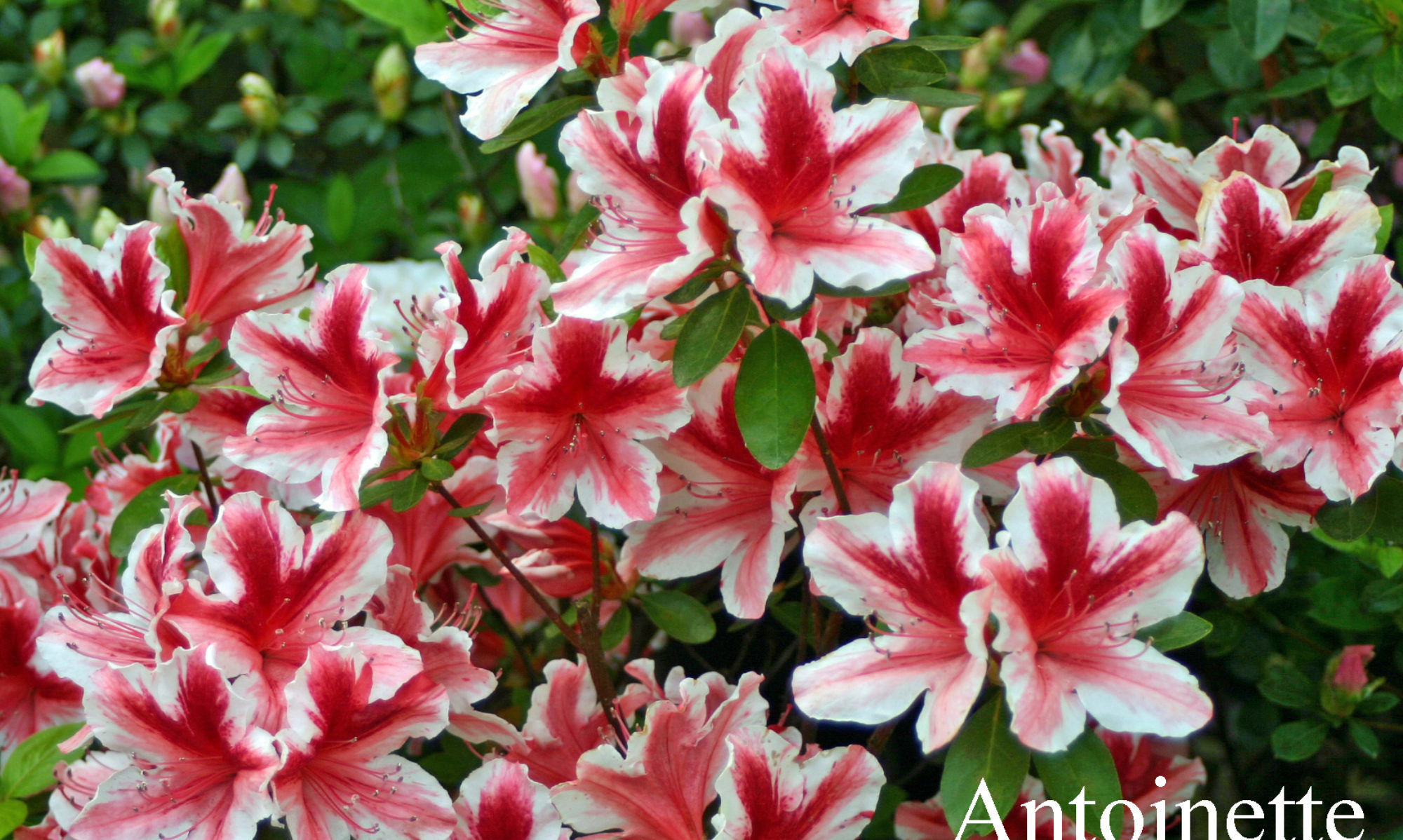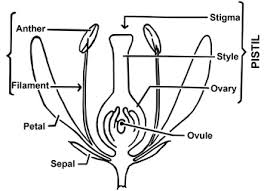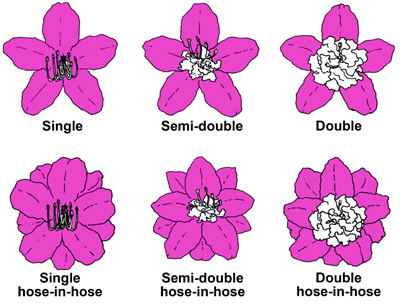Forms | Shapes and Sizes | Colors | Patterns | [Parent]
Azaleas have a wide variation of flower size, shape, form and color, which adds to their interest. The variations are also used to identify different azalea types, in terms of their flower parts:
| corolla | the petals or lobes, typically 5 and joined at the inner base of the flower. The upper petal is known as the dorsal or upper lobe. The two petals to the side of the upper lobe are known as the upper wings. The lower petals are known as the lower wings. |
| calyx | the small green triangles, typically 5, at the outer base of the flower |
| pedicel | the slender green stalk that connects the base of the flower to a branch |
| pistil | the female organ of the flower, consisting of the ovary at the inner base of the flower, a slender hollow tube (style) extending from the ovary to a small round knob at the end (stigma), which becomes sticky to receive and retain pollen |
| stamens | the male organs of the flower, typically 1 or more per petal, each consisting of a threadlike stalk (filament) extending from the inner base of the flower to a small knob at the end (anther), containing pollen. |
Forms
The different forms of azalea flowers are:
| single | 5 (typically) to 7 petals fused at the base, with a visible green calyx, and with a visible pistil and 5 (typically) to 10 visible stamens |
| hose-in-hose | the calyx is transformed into petals, such that it appears as two similar corollas, one inside the other and rotated so that all the petals are visible |
| semi-double | some stamens have been transformed completely or partially into petals, usually smaller than the outside corolla petals, and commonly contorted |
| semi-double hose-in-hose | transformed calyx and partially transformed stamens, combining the previous two forms |
| double | all the stamens have been transformed completely into petals, which may be similar in size and shape to the corolla petals, and the pistil may have been transformed, but the calyx has not been transformed |
| double hose-in-hose | the stamens and calyx have all been transformed into petals |
| spider | the petals are narrow and straplike rather than being fused at the base |
Shapes and Sizes
Variations of flower shapes are an important part of the appearance of a particular azalea variety. The shapes may change somewhat from year to year on the same plant, and they may change from plant to plant grown in different locations. Colors may also change in these ways. The exact reasons for these changes are not known.
Petal shapes range from pointy to rounded to linear.
Petal margins may be flat, wavy, ruffled or frilled, or twisted.
The overall flower shape may be tubular, funnel-shaped, bell-shaped, open, flat-faced or recurved.
Flower size, if not specified, is given as the width, or the distance between the tips of the two upper wing petals. Flower length is the distance from the base of the tube to the level of the top of the petals–in other words, the
straight height, not the sloping length of the petals.
Flower sizes range from 1/4” to as much as 5” in width for different varieties. The size may vary slightly for different plants of a given variety, particularly when planted in different locations.
Colors
Accurately describing the colors of azalea flowers is difficult. One approach is to describe a color by matching it to a complete and consistent set of color charts and names for each of the many thousands of different colors. Toward that end, a number of color charts and sets of color names have been created over the years.
Accurate color charts are difficult to print, and are therefore expensive. All but one of the color charts designed for horticultural use are out of print. The remaining chart, the Royal Horticultural Society Colour Chart of 2001, is available for around $200. Rather than naming the colors, it has 202 numbered pages, each with a different hue, with 4 color chips to a page to show the hue with deepening intensity. This gives color numbers of, for example, RHS 53D, to indicate chip D of page 53.
These definitive color names or numbers are not very useful without seeing a color chip or flower of that color. The RHS 53D number, for example, is not meaningful by itself, nor or many of the color names used in the past, such as “chatenay pink” or “neyron rose”.
The National Bureau of Standards Special Publication 440, Color Universal Language and Dictionary of Names, 1976 instead names 267 blocks in the color spectrum with a value (lightness), chroma (strength), hue modifier and hue, to give a name such as light yellowish pink. It also lists a large number of equivalent color names.
The strength of such names is their rather universal understanding without reference to a chart. The weakness of such names is their generality–light yellowish pink, for example, covers too broad a range of different colors to be useful for identifying a specific plant by color.
You can see more about colors on our Color System Help page and Color Systems page.
Color Patterns
Azalea flowers have a wide variation of color patterns. Their basic color patterns are:
| self | all one color |
| blotched | a darker or lighter different color on the top petal, often extending to the upper wing petals |
| striped | thin to wide stripes of a different color, extending from the base to the margin of any of the petals. Discontinuous stripes are usually called dots, flecks or sanding. |
| margined | thin or wide margins of a different color, on all of the petals |
| sectored | all or part of one or more petals of a different color |
Some azaleas, particularly the Satsuki azaleas, may exhibit all of these variations on the same plant. Cuttings from a branch with a particular variation tend to produce plants with primarily that variation. Cuttings from a branch with striped or sectored patterns produce plants that eventually show all the color variations.
The Japanese value these variations highly, and have named over 20 different variations.
| # | Pattern name | Translation | Explanation / Example flowers | ||
| 1 | Shiromuji | solid white | no pattern Hakurei, Hakatajiro, Benigasa | ||
| 2 | Akamuji | solid red | no pattern Kazan, Taishonishiki | ||
| in 11b | Jiai | pale, in between color | Nikko, Yama-No-Hikari, Bunka | ||
| 3 | Sokojiro | white throat | red or purple flower with the white center of the flower Seidai, Kagetsu, Shugetsu, Hagoromo-No-Hikari | ||
| 4 | Fukurin | jewel border | the opposite of sokojiro with the darker color in the inner part of the flower with the border around the petals white Nyohozan, Mine-No-Yuki Miyama-No-Yuki | ||
| 8 | Tsumajiro | white fingernail | white markings only at the tip of the petals Gyokudo, Yata-No-Kagami family | ||
| 9 | Tsumabeni | red fingernail | red or purple color only at the tip of the petals, the opposite of tsumajiro Kikoshi, Seiko-No-Tsuki, Gekkeikan | ||
| 7 | Tamafu or Shirotamafu | jewel spot | A lighter smudge of color in the very center of the petals. If this spot becomes larger it is called otamafu. Yata-No-Kagami, Shinkyo | ||
| 10 | Oshibori | major variegation | Kotobukihime, Gyoko, Maiogi | ||
| 11a | Koshibori | minor variegation | Matsukagami, Benichidori, Gobinishiki | ||
| 11b | Daisho shibori | major and minor variegation | A mixture of major variegation (thick stripes) and minor variegations (thin stripes) Kinkazan, Takara | ||
| 12 | Date shibori | flashy variegation | White crowded with a mixture of deep and light markings. Different width stripes (major and minor variegation), some extending from the edge of the petals to the base while others do not. Matsukagami, Koho, Jusho, Kagetsu, Hakurei-No-Hikari | ||
| 13 | Tate shibori | lengthwise variegation | Clear stripe that starts at the edge of the petal and goes to the base. Chiyo-No-Hikari, Fukuju, Chiyo-No-Tsuki | ||
| 19 | Hakeme shibori | brush variegation | Many fine parallel stripes Reiko, Reigetsu, Chiyo-No-Hikari, Meisei | ||
| 22 | Sarashi shibori | Many fine parallel stripes interspersed with a few thicker stripes. Matsushima, Kami-No-Yamakirin, Komei | |||
| 20 | Tobiiri shibori | patchy variegation | Irregular placing of lines smaller than those of koshibori Chiyo-No-Homare, Gyoko | ||
| 18 | Mijin shibori | fine particle variegation | Clouds of countless extremely small particles of color all over the petals. Smallest of the particle variegations. Gobinishiki, Kami-No-Yamakirin, Yayoi-No-Tsuki, Reigetsu | ||
| 16 | Fukkake shibori | spray variegation | A fine spray of many specks originating at the edges, tending toward the center of the petal. Kinkazan, Meisei, Gobinishiki, Asahi-No-Kaori | ||
| 21 | Harusame shibori | spring rain variegation | Many dots and very small lines all over the petals. Dots bigger than mijin and fukkake shibori. Eishi, Taihei, Kasho | ||
| 17 | Arare shibori | hail variegation | Many large specks scattered all over the petals. Biggest of the particle variegations. Matsu-No-Homare, Kami-No-Yamakirin | ||
| 24* | Kanoko shibori | deer-like spots variegation | A spotted shibori similar to the markings of a spotted deer skin. Marks bigger than mijin shibori Komei, Kami-No-Yamakirin | ||
| 15 | Fukiage shibori | fountain variegation | Fine sprays and streaks of color extending in a feathery pattern from the center of the petal toward the edge, also called a tsukubane shibori. Aikoku, Seiun | ||
| 23 | Hanzome shibori | half variegation | Matsukagami, Kaho, Shinsen, Hatsu-No-Hana | ||
| 14 | Shiro shibori | white variegation | white variegation on the base color of red or purple Shinkyo, Heiwa, Gunrei, Gyoten | ||
| 6 | Janome shibori | bulls-eye variegation | Fukurin with sokojiro, that is a white border and a white throat in variegation Kusudama, Sogen-No-Tsuki | ||
| 5 | Shibori sokojiro | variegation, white throat | part variegation, part white throat Kagetsu, Benikagami, Tsuki-No-Hikari, Hogetsu | ||
| in 11b | Jiai shibori | pale base with variegation | Pale color base with darker variegation Nikko, Hikari-No-Tsukasa, Yama-No-Hikari | ||
__________
# Galle’s Azaleas uses this number.
* Galle has Kano shibori, a different name, for what appears to be the same pattern.




